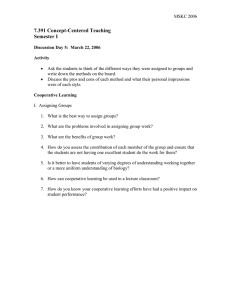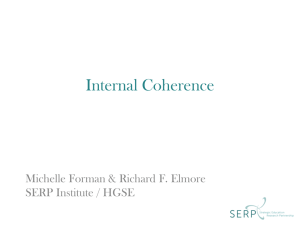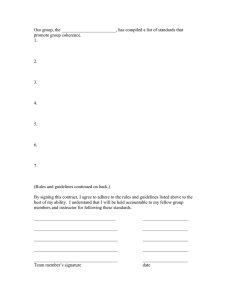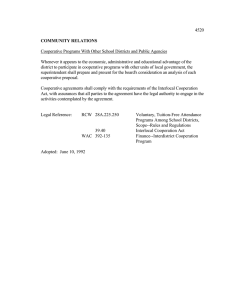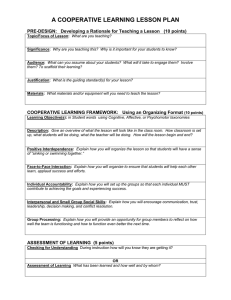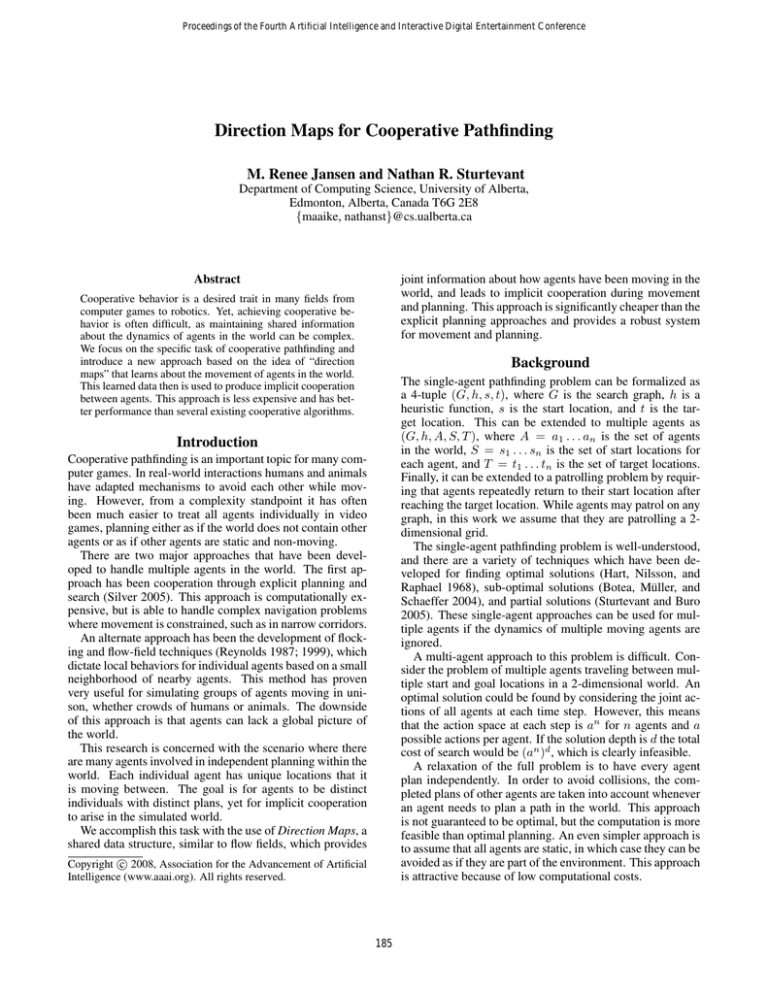
Proceedings of the Fourth Artificial Intelligence and Interactive Digital Entertainment Conference
Direction Maps for Cooperative Pathfinding
M. Renee Jansen and Nathan R. Sturtevant
Department of Computing Science, University of Alberta,
Edmonton, Alberta, Canada T6G 2E8
{maaike, nathanst}@cs.ualberta.ca
joint information about how agents have been moving in the
world, and leads to implicit cooperation during movement
and planning. This approach is significantly cheaper than the
explicit planning approaches and provides a robust system
for movement and planning.
Abstract
Cooperative behavior is a desired trait in many fields from
computer games to robotics. Yet, achieving cooperative behavior is often difficult, as maintaining shared information
about the dynamics of agents in the world can be complex.
We focus on the specific task of cooperative pathfinding and
introduce a new approach based on the idea of “direction
maps” that learns about the movement of agents in the world.
This learned data then is used to produce implicit cooperation
between agents. This approach is less expensive and has better performance than several existing cooperative algorithms.
Background
The single-agent pathfinding problem can be formalized as
a 4-tuple (G, h, s, t), where G is the search graph, h is a
heuristic function, s is the start location, and t is the target location. This can be extended to multiple agents as
(G, h, A, S, T ), where A = a1 . . . an is the set of agents
in the world, S = s1 . . . sn is the set of start locations for
each agent, and T = t1 . . . tn is the set of target locations.
Finally, it can be extended to a patrolling problem by requiring that agents repeatedly return to their start location after
reaching the target location. While agents may patrol on any
graph, in this work we assume that they are patrolling a 2dimensional grid.
The single-agent pathfinding problem is well-understood,
and there are a variety of techniques which have been developed for finding optimal solutions (Hart, Nilsson, and
Raphael 1968), sub-optimal solutions (Botea, Müller, and
Schaeffer 2004), and partial solutions (Sturtevant and Buro
2005). These single-agent approaches can be used for multiple agents if the dynamics of multiple moving agents are
ignored.
A multi-agent approach to this problem is difficult. Consider the problem of multiple agents traveling between multiple start and goal locations in a 2-dimensional world. An
optimal solution could be found by considering the joint actions of all agents at each time step. However, this means
that the action space at each step is an for n agents and a
possible actions per agent. If the solution depth is d the total
cost of search would be (an )d , which is clearly infeasible.
A relaxation of the full problem is to have every agent
plan independently. In order to avoid collisions, the completed plans of other agents are taken into account whenever
an agent needs to plan a path in the world. This approach
is not guaranteed to be optimal, but the computation is more
feasible than optimal planning. An even simpler approach is
to assume that all agents are static, in which case they can be
avoided as if they are part of the environment. This approach
is attractive because of low computational costs.
Introduction
Cooperative pathfinding is an important topic for many computer games. In real-world interactions humans and animals
have adapted mechanisms to avoid each other while moving. However, from a complexity standpoint it has often
been much easier to treat all agents individually in video
games, planning either as if the world does not contain other
agents or as if other agents are static and non-moving.
There are two major approaches that have been developed to handle multiple agents in the world. The first approach has been cooperation through explicit planning and
search (Silver 2005). This approach is computationally expensive, but is able to handle complex navigation problems
where movement is constrained, such as in narrow corridors.
An alternate approach has been the development of flocking and flow-field techniques (Reynolds 1987; 1999), which
dictate local behaviors for individual agents based on a small
neighborhood of nearby agents. This method has proven
very useful for simulating groups of agents moving in unison, whether crowds of humans or animals. The downside
of this approach is that agents can lack a global picture of
the world.
This research is concerned with the scenario where there
are many agents involved in independent planning within the
world. Each individual agent has unique locations that it
is moving between. The goal is for agents to be distinct
individuals with distinct plans, yet for implicit cooperation
to arise in the simulated world.
We accomplish this task with the use of Direction Maps, a
shared data structure, similar to flow fields, which provides
c 2008, Association for the Advancement of Artificial
Copyright Intelligence (www.aaai.org). All rights reserved.
185
when a slightly longer path might have a lower chance of
failure. As a result, the movement of agents can be quite
chaotic.
A problem which is similar to multi-agent pathfinding is
the simulation of groups of agents traveling through a world,
known as flocking (Reynolds 1987). Flocking simulations
use a small set of rules for movement from which group behavior emerges. Flocking problems can be seen as a subset
of the tasks we consider here, but the goal is usually more related to simulating group movement, as opposed to solving
a pathfinding problem.
Cooperative behavior can also be achieved with steering techniques (Egbert and Winkler 1996; Reynolds 1999).
These techniques assume that the agent is parameterized by
a steering force vector, which describes the speed and direction of movement of the agent. Some steering behaviors that are similar to our approach are path following, in
which agents follow a path but are allowed to deviate from
it to some distance, and flow field following, in which the
agent moves in the direction of the local tangent of a flow
field. Our approach provides a mechanism to automatically
build flow-fields, instead of requiring it to be provided by
an external user, as is done in games such as Assassin’s
Creed (Bernard and Therien 2008). This has the potential
to significantly reduce design times.
In the physical world ants are faced with real patrol tasks
when collecting food, and they do this by following feromone trails left behind by other ants. Research in biology (Couzin and Franks 2003) has shown that rules for individual ant behavior lead to group behavior in which lanes
are formed so that collisions are minimized. Their rules are
derived from physical experiments with ants, and are similar
to our approach.
In ants and other insects, a phenomenon called stigmergy
is observed. This term is used to describe the indirect communication within groups of insects that arises because the
insects modify the environment, for example by laying feromone trails (Dorigo, Bonabeau, and Theraulaz 2000). The
behavior of real-life ants has inspired stigmergy-based algorithms for a number of applications such as optimization
problems. In Ant System, for example, virtual feromones
were used to do optimization in problems such as the traveling salesman problem (Dorigo, Maniezzo, and Colorni
1996).
Finally, this work bears some resemblance to potential
field methods which have been used in robotics. An example of this is Arkin’s work on robot navigation, which uses
potential fields to guide the robots (Arkin 1987). The potential field consists of vectors which attract the robot towards
a goal, and repel it from obstacles. This is combined with
high-level behaviors to direct the robot’s speed and movement direction.
Figure 1: An example reservation table.
These approaches form two extremes on a spectrum. The
first approach shares a large amount of data about other
agents’ plans. This data is continually changing and as a
result, algorithms that use the data are complex. The second
approach shares a much smaller amount of data, so algorithms that use the data are simpler. Obviously a simpler
approach is preferred, but static data quickly becomes inaccurate in a dynamic world and may lead to poor behavior.
However, the trade-offs suggests a different approach.
Planning with static data is simpler, but a static snapshot
of where agents stand in the world gives very little information that is useful for cooperation. Therefore, instead
of using static data about the location of other agents, we
propose to build and use static data about the dynamics of
the world. That is, data about how agents have historically
moved through the environment. This approach is not only
simpler than explicit cooperative approaches, but it is also
robust and gives rise to emergent cooperation.
If agents share their plans globally and have access to all
other agent plans, the 2-dimensional search space is turned
into a 3-dimensional plan space, where time is the third dimension. Agents must ensure that their planned paths never
pass through the same location at the same time as the path
of another agent. This idea is demonstrated in Figure 1,
which shows a data structure that could be used for communication between agents. In this figure the z-axis is time,
and agents share where they plan to travel at each point in
the future. Agent 1 has planned to move along the x-axis
and Agent 2 has planned to move along the y-axis. Agent 1
is assured that Agent 2 will move out of the way in time so
that they will not collide.
This approach has been used to solve a traffic management problem (Dresner and Stone 2004) as well as for cooperation within games in Windows Hierarchical Cooperative A* (WHCA*) (Silver 2005) and Cooperative PartialRefinement A* (CPRA*) (Sturtevant and Buro 2006). This
type of cooperative search can be very expensive, especially
with inaccurate heuristics. WHCA* first builds a more accurate heuristic for the multi-agent planning problem by solving the single-agent problem. To further reduce computational costs, it performs a windowed search through the cooperative space, reverting to a single agent computation after the window is exceeded. This idea can be combined
with Partial-Refinement A* (PRA*) (Sturtevant and Buro
2005) to form CPRA*, which uses abstraction and partial
refinement to produce similar paths while reducing memory and computation overheads. One drawback to these
approaches is that they look for the shortest path possible,
Direction Vectors and Maps
This section describes implicit cooperative pathfinding using direction maps. This includes a method for learning the
direction maps, as well as various methods for using the
direction maps when planning. The learning and planning
methods are intertwined. We first define a direction vector
186
(DV), a direction map (DM) and a movement vector (MV).
Then we show how, given a complete DM, we we can plan
using the DM. Finally, we show that the planning process in
itself is sufficient for learning a DM, and formally define the
DM learning process.
(a)
(b)
Definitions
To begin, we assume the world is divided into cells. Cells
can be the result of dividing a map using any number of
methods. For simplicity, we present this approach given that
a map is divided into a grid, with each cell the size of a single
agent, although other divisions are possible.
Associated with each cell in the world is a Direction Vector (DV). A DV is a vector with length between zero and one,
and is a representation of the expected direction in which
agents will move through a cell. The length of a DV can
be seen as the strength of the correlation. A Direction Map
(DM) is the complete collection of DV’s for a map, one for
each cell. An example of a DM and DV’s is in Figure 2.
DM-like concepts have been featured in other work, such
as (Arkin 1987; Reynolds 1999), but they are used for different purposes and built in different ways.
One step of movement by a agent in the world is represented by a Movement Vector (MV). A MV always has unit
length and, in a grid world, points in one of 8 directions.
Figure 2: An example of planning with a DM.
In this formulation, cooperative pathfinding is achieved
by changing the underlying problem definition. The goal is
no longer to find the shortest path, but instead to find the
lowest-cost path, following the general direction of other
agents in the world. Cooperative pathfinding results not because this allows explicit cooperation, but because agents
are unlikely to collide since all units passing through a given
location will be traveling the same general direction.
As a side-effect, inexpensive agents can be added to
the world which perform a form of flow-field following (Reynolds 1999) on the DM. This is achieved with a
greedy one-step lookahead. Units will follow the direction
map closely, and at little cost, as they are only expanding
one node at each time step.
Learning Formulation
Planning using DM’s
A DM can be learned from the movements of agents as they
traverse the world. Although a static DM can be used for
planning, a dynamic DM that is updated as agents move can
also be used. The process of learning a DM and the individual DV’s can be formulated in several different ways. The
simplest explanation is that each DV is simply computing
a recency-weighted average of the MV’s of all agents that
have passed through each cell on the map.
In practice, DV’s can be broken into their x- and ycomponents and learned independently. In this formulation,
given that the agent is following a movement vector, MV, at
a cell with direction vector, DV, the DV is updated when the
agent enters and leaves the cell:
Given a DM, it can be used to modify the planning process
of any heuristic search algorithm. The DM is used to change
the underlying costs of traversing the world, instead of modifying a search algorithm. For instance, A* expands nodes
in order of f -cost, where f = g + h. Weighted-A* adds a
weight to the heuristic function in order to encourage expanding nodes with lower heuristic cost. When planning
with a DM, the opposite is done. The cost of traversing an
edge (the g-cost) is modified by the DV at either end of the
edge being traversed.
The goal of a DM is to encourage cooperative movement.
So, movement which is congruent with the DV’s in the DM
should be encouraged, while movement in the opposite direction should be discouraged. The exact penalty for moving in the opposite direction of the DV is a parameter, wmax .
Consider the example in Figure 2. A agent moving from (a)
to (b) is moving in the same direction as the DV’s at both
(a) and (b). Thus, the penalty should be 0. However, if the
agent is moving from (b) to (a), it will be moving against the
DV’s at both (a) and (b), so the penalty for this movement is
wmax .
In general, when moving between cells a and b, let the
underlying cost of the edge between a and b be wab , and
let the direction vectors at a and b respectively be DVa and
DVb . Finally, let M Vab be the movement vector associated
with movement between a and b. The dot-product of the DV
and MV will range between -1 and 1, so the cost of moving
between a and b is wab + 0.25 · wmax (2 − DVa · M Vab −
DVb · M Vab ). It is important that the DV of both the initial
and final cell are taken into account, because we want the
cost of the edge to reflect the congruence with both DV’s.
DVx ← (1 − α)DVx + αM Vx
DVy ← (1 − α)DVy + αM Vy
In this formulation, α can vary between 0 and 1, controls
the weighted average, and can be seen as a learning rate.
For higher values of α an individual DV will change very
quickly as agents move around the map, while with low values each DV will change more slowly.
Although this is a simple formulation of the learning problem, there is a formal justification of the learning process.
With a small amount of algebraic manipulation, it can be
shown that these equations are equivalent to the perceptron
learning rule (Russell and Norvig 1995). In this formulation, there is a perceptron at each cell in the DM which is
attempting to predict the direction that a agent will move
through that cell. The perceptron will learn a DV that can
then be used for planning.
We demonstrate the learning process in Figure 3. In this
example α = 0.5. Imagine that a agent, indicated by “A”
187
A
A
Start
Goal
(a) Step 1
Start
A
Goal
Start
(b) Step 2
Goal
(c) Step 3
Figure 3: Learning DV’s.
wants to travel two steps to the right, to the state marked
“Goal”. As the agent takes the first step, moving directly to
the right, the MV, v, is (1, 0). The agent’s current location
does not yet have a DV associated with it, so as the agent
moves, the DV stored there is
Figure 4: Using abstraction for planning.
normally travel to a particular point within an abstract sector
when refining the abstract plan into a concrete path. The
alternate proposed here is to find the shortest path to any
point inside the next sector on the abstract path. This allows
the agent to effectively follow the DM without traveling too
far out of the way of the intended path. The final path which
is followed is indicated by a dashed line.
There are a number of very minor implementation details
which can cause this approach to fail; these most often occur
when a agent is standing on or near the boundary between
abstract sectors. The easiest fix is for a agent to always plan
one step ahead in the abstract path. In Figure 4, this would
result in the agent planning directly from the start to the goal.
This improves the overall quality of the paths, but increases
the computational costs.
(α · vx , α · vy ) = (0.5, 0)
The DV for the agent’s new location, in the center of the
map, will also be updated. The new value for this DV is
((1 − α) · DVx + α · vx , (1 − α) · DVy + α · vt )
= (0.5 · 0 + 0.5 · 1, 0.5 · 1 + 0.5 · 0)
= (0.5, 0.5).
As this vector has a magnitude greater than 1, we normalize:
1
1
DV = ( √ , √ )
2
2
On the next step, when the agent moves into its goal location, the agent updates the center location again. Using
the same calculation as before, the DV stored here will be
approximately (0.85, 0.35). The last state that is updated is
the goal state. Since no DV was stored here yet, we compute
the DV similarly to the way we computed it for the agent’s
start location. The resulting DV is (0.5, 0).
Instead of only updating visited states, the agent can also
update neighbors of these states. This allows the agents to
create wider corridors as they move. In our implementation,
whenever an agent moves, it also updates all eight locations
surrounding it using a smaller value for the learning rate.
Experimental Results
We have tested DM’s in a variety of scenarios with many
different parameters. A representative subset of the results
is described here. In the experiments we place units on a
map and assign two unique locations to each unit, asking the
units to patrol between the locations a fixed number of times.
We chose to evaluate this approach with patrolling tasks because they are common in many games. For instance, almost
all RTS games have units patrolling back and forth between
resources and a home base.
In this context we can measure a number of statistics
about the unit performance. These include the average number of nodes expanded per patrol per agent, the total time
taken to finish all patrols (simulation time, not CPU time),
the average path length of a single patrol, and the average
number of times per patrol loop that an action failed because
another agent was in the way.
These metrics are useful, but the result of this work is a
dynamic result; one that can visually be observed, but that
is difficult to quantify experimentally. As a result, we define
a new metric, coherence, which is a numerical measurement
of how coherently agents travel in the world. The coherence
of agent movement on a map can vary from 0 to 1, although
movement through a map is naturally coherent, so low coherence values will never be found in practice.
Reducing Costs Using Abstraction
Planning using DM’s is more expensive than using localrepair A*, because the heuristic takes into account the underlying topology, not the topology of the DM. A common
solution is to reduce the length of the paths that are planned,
which can be done with a simple abstraction mechanism. We
divide the world into sectors, and, at a high-level, plan paths
between sectors, an approach similar to (Sturtevant 2007).
When refining the abstract plan into a low-level path, we
then use the DM to plan.
We illustrate this process in Figure 4. In this example, the
agent wants to travel from the top left to the bottom right of
the map. At an abstract level, the map is divided into sectors,
and the agent plans to travel through the three sectors, as
outlined in the figure. In previous approaches, agents would
188
2.5
0.80
2.0
0.75
1.5
1.0
Coherence
Nodes Expanded (
106)
3.0
0.70
Coherence
0.5
Nodes Expanded
0.65
0
0
5
10
15
Weight (w max)
20
Figure 5: Relationship between coherence and wmax .
(a) Using DM
(b) Not using DM
Figure 6: The DM’s generated when we are and when we
are not using the DM for planning
Coherence is computed as follows: for every DV, we define DVt as the DV in the neighboring cell pointed to by
the DV. We then compute the length of a new vector formed
from the average of the x and y components of DV and DVt .
The coherence of the map is the average of these lengths
over all DV’s.
We begin by evaluating the learning process. In our
first experiment, we place 100 patrolling units on an empty
64×64 map, and vary the weight wmax assigned when traveling against the DV. When planning, agents avoid static obstacles within a small radius, and use α = 0.6. In Figure 5
we graph the results. The x-axis is wmax . On the right axis
we plot coherence, shown as a dotted line. On the left axis
we plot the number of nodes expanded. This graph shows
that we can directly increase the coherence by assessing a
larger penalty on units who travel against the DM, with a
trade-off in the number of nodes expanded. The coherence
graph has a fairly sharp ‘elbow’ indicating that most of the
coherence gains can be achieved with a weight of 5 or less.
In Figure 6 we show a portion of the resulting DM in
this scenario. In 6(a) the DM is used with a weight of 15,
whereas a weight of 0 is used in 6(b). This is equivalent to
not using the DM, although the DM still maintains a DV at
each point. This clearly illustrates the effect the DM has on
units’ travel.
In our next experiments, we compare the performance of
units controlled by direction maps to those controlled by
WHCA* (Silver 2005). We present an evaluation based on
the metrics in Table 1. For the DM, A* is used with a visibility radius 5, weight wmax = 10 and α = 0.4. WHCA*
has a cooperative a window size of 4. In this experiment we
used the 32×32 map in the left part of Figure 7. 20 agents
started in the bottom portion of the map and patrolled between opposite sides of the bottom of the map.
The table shows that WHCA* expands more than five
times the number of nodes than the DM. The reason is that
WHCA* performs its search including a dimension of time,
whereas the DM approach only searches in two-dimensional
(x/y) space. Units using WHCA* have a shorter path length,
and thus take less simulation time to complete the scenario
because WHCA* is specifically looking for short paths,
whereas the DM approach puts more emphasis on coher-
Figure 7: Two sample maps used for experimentation.
ent paths by following the DM. Since WHCA* maintains
a reservation table, the number of collisions is also significantly smaller than in the DM case.
From this data, it may seem that WHCA* should be used
if the approach is affordable. But, this data does not compare the coherence of the units movement. We compare the
coherence of several approaches in Figure 8. The x-axis of
this graph is simulation time. At time 0, the DM is blank,
so the curves change as more learning takes place. In practice, the DM could be learned offline and loaded at runtime,
avoiding the time required for learning.
The best coherence is achieved by using DM’s with the
neighborhood update rule. This approach more gradually
achieves coherence because the neighborhood update rule
results in many more cells having low-weight DV’s, resulting in a lower overall coherence score. Surprisingly,
WHCA* has the worst performance, even worse than regular A* with no DM. This is because WHCA* is only trying
to find a fast route, not a coherent one.
In our last set of experiments, we compare planning costs
using abstraction with the costs using regular A* and without using abstraction. We present results for 64×64 versions
of the two maps in Figure 7 in Tables 2 and 3 respectively.
50 units start on each side of the map in the darkened areas
and patrol back and forth from opposite sides of the map.
189
Nodes expanded
Simulation time (s)
Path length
Failed moves
WHCA*
5813.43
83.02
70.25
0.33
DM
1065.74
110.55
76.44
1.98
Nodes Exp.
Sim. Time
Path Length
Failed Moves
Table 1: Comparison of WHCA* and direction maps
DM
Coherence
No DM
WHCA*
0.7
0.6
0.5
0.4
0
100 200 300 400 500 600 700 800
Time (s)
Figure 8: Comparison of map coherence for WHCA* and
direction maps
The heuristic in the first map is less accurate than in the second map, hence the larger number of nodes expanded. In the
best case abstraction reduces the number of nodes expanded
to roughly the same as A*, however there can be significant
variation depending on the sector size.
Nodes Exp.
Sim. Time
Path Length
Failed Moves
A*
4000.82
5003.94
149.49
21.55
DM
5438.95
4644.99
150.45
8.08
DM-8
1426.57
4730.37
151.95
7.54
DM-8
2078.51
4580.88
135.66
7.81
DM-16
2795.56
4491.18
131.77
7.18
IEEE International Conference on Robotics and Automation, volume 4, 264–271.
Bernard, S., and Therien, J. 2008. Creating believable
crowds in assassins creed. Game Developers Conference.
Botea, A.; Müller, M.; and Schaeffer, J. 2004. Near optimal
hierarchical path-finding. J. of Game Develop. 1(1):7–28.
Couzin, I. D., and Franks, N. 2003. Self-organized
lane formation and optimized traffic flow in army ants.
Proceedings of the Royal Society of London, Series B
270(1511):139–146.
Dorigo, M.; Bonabeau, E.; and Theraulaz, G. 2000. Ant
algorithms and stigmergy. Future Generation Computer
Systems 16(9):851–871.
Dorigo, M.; Maniezzo, V.; and Colorni, A. 1996. The Ant
System: Optimization by a colony of cooperating agents.
IEEE Transactions on Systems, Man, and Cybernetics Part
B: Cybernetics 26(1):29–41.
Dresner, K., and Stone, P. 2004. Multiagent traffic management: A reservation-based intersection control mechanism. In The Third International Joint Conference on Autonomous Agents and Multiagent Systems, 530–537.
Egbert, P. K., and Winkler, S. H. 1996. Collision-free object movement using vector fields. IEEE Computer Graphics and Applications 16(4):18–24.
Hart, P.; Nilsson, N. J.; and Raphael, B. 1968. A formal basis for the heuristic determination of minimum cost
paths. IEEE Transactions on Systems Science and Cybernetics 4:100–107.
Reynolds, C. W. 1987. Flocks, herds, and schools: A distributed behavioral model. Computer Graphics 21(4):25–
34.
Reynolds, C. 1999. Steering behaviors for autonomous
characters. Game Developers Conference.
Russell, S., and Norvig, P. 1995. Artificial Intelligence: A
Modern Approach. Englewood Cliffs, NJ: Prentice Hall.
Silver, D. 2005. Cooperative pathfinding. In AIIDE, 117–
122.
Sturtevant, N., and Buro, M. 2005. Partial pathfinding
using map abstraction and refinement. In Proceedings of
AAAI, 47–52.
Sturtevant, N., and Buro, M. 2006. Improving collaborative pathfinding using map abstraction. In AIIDE, 80–85.
Sturtevant, N. R. 2007. Memory-efficient abstractions for
pathfinding. In AIIDE, 31–36.
DM, Surround
0.8
DM
4001.19
4382.55
131.60
6.59
Table 3: DM’s with abstraction (map2)
1
0.9
A*
2187.73
4993.83
140.00
19.92
DM-12
3127.52
4737.54
150.94
8.96
Table 2: DM’s with abstraction (map1)
Conclusions
In this paper we have presented the idea of direction maps
and shown how they can be used to induce cooperative
pathfinding when used during planning. This approach fills
the gap between flocking-like approaches, and other approaches which are more planning pased. We have also
shown how direction maps can be learned automatically as
units traverse the world. The learning rule for direction maps
could also be used to automatically learn flow fields.
In the future we plan to extend these ideas to provide a
more hybrid approach. Direction maps are well suited to
environments in which all units are continually moving. But,
we would like to combine the idea of planning with direction
maps with cooperative A* to provide an even more robust
planning system.
References
Arkin, R. 1987. Motor schema based navigation for a mobile robot: An approach to programming by behavior. In
190

